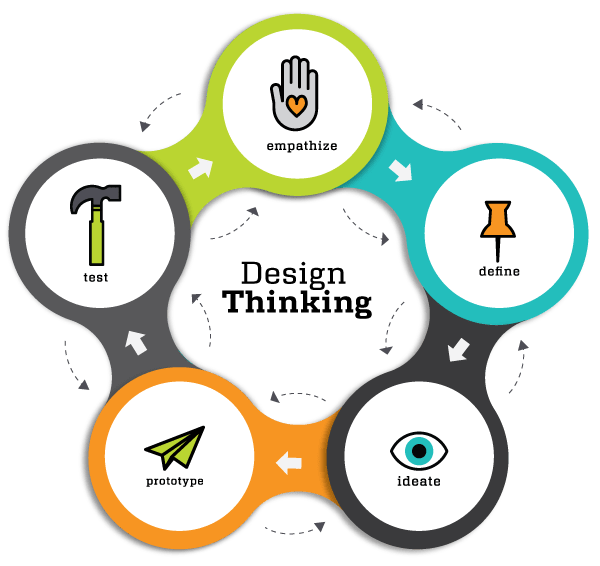What do Netflix, UberEats and Oral B all have in common? They all used a type of approach to problem-solving known as Design Thinking.
What is Design Thinking?
Also known as Human-Centered Design, Design Thinking is a non-linear iterative process. It’s used to understand the end user, challenge assumptions, and redefine problems. We can visualize this continuous process with five steps: empathize, define, ideate, prototype and test.
We start with a problem statement like “How might we make a __________ better?” Here’s an example: How might we make a wallet better?
Empathize: In the first step, we’ll think about empathizing with someone about designing a better wallet. To get started, you’ll interview the person and make sure to take notes! You may ask…
- What do they like about their current wallet? Why do they like that feature?
- What do they do if someone asks for their ID/transit pass?
- What about their wallet makes them frustrated?
Keep asking questions—pretend you’re a toddler trying to learn about the wallet for the first time. It seems silly, sure, but what did you learn? Maybe this person is frustrated that loose change falls out of their wallet. Or it’s got so many cards it’s hard to keep in a pocket. Bring curiosity to this stage, and you’ll be able to build on questions and learn more before moving to the next step.
Define: This is the narrowing part of the process. Drill down to a specific user, their need and the insight behind that need. Review your notes—what is important to the user/customer? What do they value? Now reframe the problem with what you learned. For the wallet example, this might look like, “How might we design a secure accessory to hold money and important cards?”
Ideate: Let the ideas flow based on what you now know! Generate as many ideas as possible based on the problem statement you defined in the previous step. If you’re working with a team, build off each other’s ideas by saying them out loud as you write them on a sticky note. It’s best to do this with no filter; there’s time for that later. You’ll prioritize and find a potential fit for your ideas in the next step.
Prototype: A prototype is an early sample or expression of your potential product made to learn or test your idea. Evaluate the feasibility of the ideas you generated and pick ones you can create simple versions to try with your customer/problem holder. It doesn’t have to be fancy—cardboard or wireframes drawn on a napkin can work.
Test: The test mode is where we put our prototypes in the hands of users in the context of their life. It informs further changes or iterations. Watch how your customer/problem holder reacts/interacts with your prototype during this step. Think about how you can improve it further. Don’t get too attached; your prototype will change, and that’s a good thing.
Design Thinking is a continual process which allows ideas to get to better solutions. This could be trying your prototype with a new customer/problem holder. Can you drill down more in the define step? Did you come up with a new idea in ideate mode? Or maybe you learned something new about the problem holder in empathize mode. These learnings are data which can help you focus on the most important factors in addressing the problem. Netflix and UberEats weren’t just “a-ha!” lightbulb moments; now that you know how these mega-brands connected with problem holders, it’s your turn to apply it to your idea!
Ready to explore these stages in more detail?
The Edmonton Public Library and Innovate Edmonton have teamed up to offer Innovation U: a four-course entrepreneurial series delivered in-person to Edmontonians with big ideas! The third session is about design thinking. Sign up for the waitlist or check out Edmonton Unlimited's website for upcoming sessions of Business Model 101. If you need a little extra help our Innovator in Residence, Catherine Warren also has some upcoming office hours so you can have some one-on-one time with an expert.




Add a comment to: What is Design Thinking?